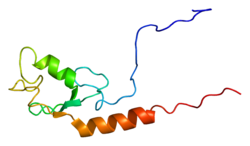Protein-coding gene in the species Homo sapiens
| UBE4A |
|---|
 |
| Available structures |
|---|
| PDB | Ortholog search: PDBe RCSB |
|---|
|
|
| Identifiers |
|---|
| Aliases | UBE4A, E4, UBOX2, UFD2, ubiquitination factor E4A, NEDHMS |
|---|
| External IDs | OMIM: 603753; MGI: 2154580; HomoloGene: 3517; GeneCards: UBE4A; OMA:UBE4A - orthologs |
|---|
| Gene location (Human) |
|---|
 | | Chr. | Chromosome 11 (human)[1] |
|---|
| | Band | 11q23.3 | Start | 118,359,600 bp[1] |
|---|
| End | 118,399,211 bp[1] |
|---|
|
| Gene location (Mouse) |
|---|
 | | Chr. | Chromosome 9 (mouse)[2] |
|---|
| | Band | 9|9 A5.2 | Start | 44,834,425 bp[2] |
|---|
| End | 44,876,898 bp[2] |
|---|
|
| RNA expression pattern |
|---|
| Bgee | | Human | Mouse (ortholog) |
|---|
| Top expressed in | - endothelial cell
- Brodmann area 23
- middle temporal gyrus
- visceral pleura
- parietal pleura
- pons
- skin of thigh
- trigeminal ganglion
- superior vestibular nucleus
- inferior ganglion of vagus nerve
|
| | Top expressed in | - muscle of thigh
- neural layer of retina
- genital tubercle
- spermatocyte
- ganglion of vagus nerve
- granulocyte
- zygote
- tail of embryo
- yolk sac
- ventricular zone
|
| | More reference expression data |
|
|---|
| BioGPS |  | | More reference expression data |
|
|---|
|
| Gene ontology |
|---|
| Molecular function | - ubiquitin-protein transferase activity
- protein binding
- transferase activity
- ubiquitin-ubiquitin ligase activity
| | Cellular component | - ubiquitin ligase complex
- nucleus
- cytoplasm
| | Biological process | - protein ubiquitination
- ubiquitin-dependent protein catabolic process
- ubiquitin-dependent ERAD pathway
- protein polyubiquitination
| | Sources:Amigo / QuickGO |
|
| Orthologs |
|---|
| Species | Human | Mouse |
|---|
| Entrez | | |
|---|
| Ensembl | | |
|---|
| UniProt | | |
|---|
| RefSeq (mRNA) | | |
|---|
NM_145400
NM_001346698
NM_001361075
NM_001361076 |
|
|---|
| RefSeq (protein) | | |
|---|
NP_001333627
NP_663375
NP_001348004
NP_001348005 |
|
|---|
| Location (UCSC) | Chr 11: 118.36 – 118.4 Mb | Chr 9: 44.83 – 44.88 Mb |
|---|
| PubMed search | [3] | [4] |
|---|
|
| Wikidata |
| View/Edit Human | View/Edit Mouse |
|
Ubiquitin conjugation factor E4 A is a protein that in humans is encoded by the UBE4A gene.[5][6]
The modification of proteins with ubiquitin is an important cellular mechanism for targeting abnormal or short-lived proteins for degradation.
Ubiquitination involves at least three classes of enzymes: ubiquitin-activating enzymes, or E1s, ubiquitin-conjugating enzymes, or E2s, and ubiquitin-protein ligases, or E3s. This gene encodes an additional conjugation factor, E4, which is involved in multiubiquitin chain assembly.[6]
References
- ^ a b c GRCh38: Ensembl release 89: ENSG00000110344 – Ensembl, May 2017
- ^ a b c GRCm38: Ensembl release 89: ENSMUSG00000059890 – Ensembl, May 2017
- ^ "Human PubMed Reference:". National Center for Biotechnology Information, U.S. National Library of Medicine.
- ^ "Mouse PubMed Reference:". National Center for Biotechnology Information, U.S. National Library of Medicine.
- ^ Koegl M, Hoppe T, Schlenker S, Ulrich HD, Mayer TU, Jentsch S (Apr 1999). "A novel ubiquitination factor, E4, is involved in multiubiquitin chain assembly". Cell. 96 (5): 635–44. doi:10.1016/S0092-8674(00)80574-7. PMID 10089879.
- ^ a b "Entrez Gene: UBE4A ubiquitination factor E4A (UFD2 homolog, yeast)".
Further reading
- Robertson NG, Khetarpal U, Gutiérrez-Espeleta GA, et al. (1995). "Isolation of novel and known genes from a human fetal cochlear cDNA library using subtractive hybridization and differential screening". Genomics. 23 (1): 42–50. doi:10.1006/geno.1994.1457. PMID 7829101.
- Nagase T, Seki N, Tanaka A, et al. (1996). "Prediction of the coding sequences of unidentified human genes. IV. The coding sequences of 40 new genes (KIAA0121-KIAA0160) deduced by analysis of cDNA clones from human cell line KG-1". DNA Res. 2 (4): 167–74, 199–210. doi:10.1093/dnares/2.4.167. PMID 8590280.
- Mahoney JA, Odin JA, White SM, et al. (2002). "The human homologue of the yeast polyubiquitination factor Ufd2p is cleaved by caspase 6 and granzyme B during apoptosis". Biochem. J. 361 (Pt 3): 587–95. doi:10.1042/0264-6021:3610587. PMC 1222341. PMID 11802788.
- Strausberg RL, Feingold EA, Grouse LH, et al. (2003). "Generation and initial analysis of more than 15,000 full-length human and mouse cDNA sequences". Proc. Natl. Acad. Sci. U.S.A. 99 (26): 16899–903. Bibcode:2002PNAS...9916899M. doi:10.1073/pnas.242603899. PMC 139241. PMID 12477932.
- Gevaert K, Goethals M, Martens L, et al. (2004). "Exploring proteomes and analyzing protein processing by mass spectrometric identification of sorted N-terminal peptides". Nat. Biotechnol. 21 (5): 566–9. doi:10.1038/nbt810. PMID 12665801. S2CID 23783563.
- Contino G, Amati F, Pucci S, et al. (2004). "Expression analysis of the gene encoding for the U-box-type ubiquitin ligase UBE4A in human tissues". Gene. 328: 69–74. doi:10.1016/j.gene.2003.11.017. PMID 15019985.
- Gerhard DS, Wagner L, Feingold EA, et al. (2004). "The status, quality, and expansion of the NIH full-length cDNA project: the Mammalian Gene Collection (MGC)". Genome Res. 14 (10B): 2121–7. doi:10.1101/gr.2596504. PMC 528928. PMID 15489334.
- Spinette S, Lengauer C, Mahoney JA, et al. (2006). "Ufd2, a novel autoantigen in scleroderma, regulates sister chromatid separation". Cell Cycle. 3 (12): 1638–44. doi:10.4161/cc.3.12.1345. PMID 15611659.
- Ewing RM, Chu P, Elisma F, et al. (2007). "Large-scale mapping of human protein-protein interactions by mass spectrometry". Mol. Syst. Biol. 3 (1): 89. doi:10.1038/msb4100134. PMC 1847948. PMID 17353931.
 | This article on a gene on human chromosome 11 is a stub. You can help Wikipedia by expanding it. |

 1wgm: Solution structure of the U-box in human ubiquitin conjugation factor E4A
1wgm: Solution structure of the U-box in human ubiquitin conjugation factor E4A



















